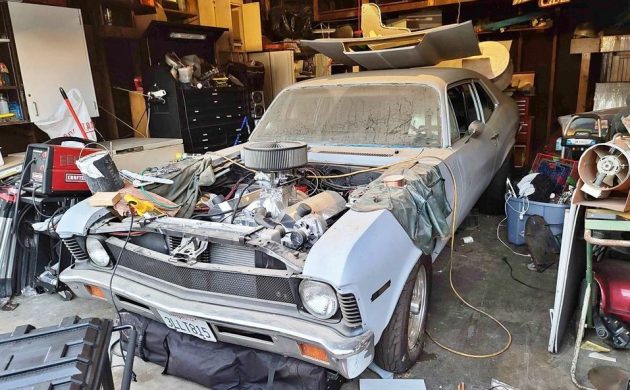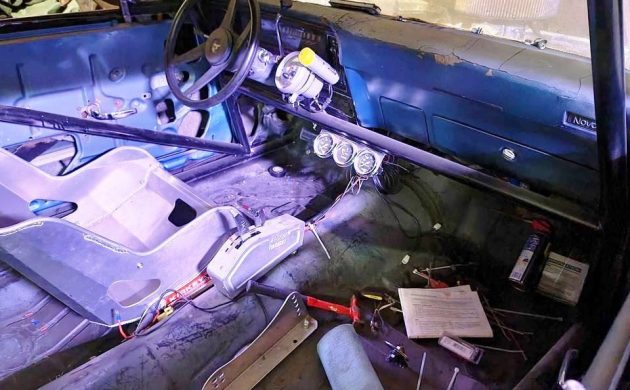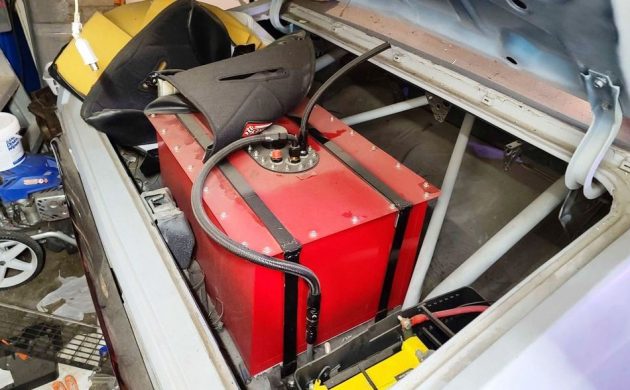Shoehorning a built big block into a Nova inevitably leads to various possible conclusions. Count on giant grins for sure, and trouble from The Law, with broken parts coming along as a near certainty. This 1971 Chevrolet Nova in Ontario, Canada may have seen its share of all those, but the only one that’s certain is that the mighty engine needs bearings after being “smoked” last time it went down the drag strip, according to the seller. The listing on Facebook Marketplace asks a firm $14,000 for what looks like a solid and well-engineered drag car.
A Chevy big block punched out to 498 cid (8.1L) and topped with Dart Pro-1 aluminum heads made a dyno-documented 730 hp and 656 lb-ft of torque before giving up the ghost. It takes more than bolt-ons to push a big block’s horsepower number above the torque. A beefed-up GM Turbo-Hydramatic 400 three-speed automatic transmission changes the gears, sending power rearward to a locking Ford nine inch rear end with 3.73:1 gears. Make sure your steering wheel is pointed straight ahead before dropping the hammer on this one, folks. It might not hurt to update your Last Will and Testament too.
It’s all business in the stripped-out cockpit. If you like your 700 HP Nova family vacation-ready, you’ve got some work to do. The roll cage adds peace of mind and structure to the unibody Nova. I’ve heard at least one story of a built V8 with solid engine mounts bending a Nova’s front subframe. Unlike some cars with giant engines, this one’s budget extended to some aftermarket suspension and other upgrades as well.
That giant red fuel cell barely leaves room for an overnight bag. All joking aside, this is a serious machine, and real buyers will know the questions to ask. Do you have what it takes to uncork this high-powered big-block Chevy?








Why such a large fuel cell for only going a 1/4 mile at a time? More fuel, more weight.
Serious bracket cars use large fuel cells like this one. Tracks hot lap cars in later rounds, especially those that have a curfew. At a minimum it takes several additional minutes to return to a pit and add gas. My old track, on more than one occasion had to run rounds before all of the competitors made it back to the staging lanes. The track had no choice if they wanted to finish the race.
Small fuel cell are a dead giveaway that the car is either not competitive or just a grudge night bomber.
Steve R
It looks like a bit of thought went into the engine but my biggest question would be what does give up the ghost mean? I see an expired engine like this and RODS as in broken are the first thing I think of! Then if that’s the case it could be anything to everything that could be seriously broken? If that’s the case it’s a lost cause as far as the engine is concerned.
Hard pass!,a fresh big block is like 15k +,then it looks like it’s been sitting quite a while, you’d end up dumping 25 I easy,on top of 14 k,no thanks,race cars can be had cheaper,or just spend 25-30 k on a nice street nova.
Hard pass!,a fresh big block is like 15k +,then it looks like it’s been sitting quite a while, you’d end up dumping 25 k easy,on top of 14 k,no thanks,race cars can be had cheaper,or just spend 25-30 k on a nice street nova.